Medicinal plants have been used to treat diseases or to attain or maintain a condition of improved health from a long time. They are both promotive and preventive in their approach. It is a comprehensive system, which uses various remedies derived from plants and their extracts to treat disorders and to maintain good health. Natural herbs like triphala, tulsi patra, jyestiamadh, neem, clove oil, pudina, ajwain and many more used either as whole single herb or in combination have been scientifically proven to be safe and effective medicine against various oral health problems like bleeding gums, halitosis, mouth ulcers and preventing tooth decay. The major strength of these natural herbs is that their use has not been reported with any side-effects till date[1]. Use of herbal derivatives for oral healthcare and dental hygiene maintenance has been continuing since times immemorial. If we look back at the methods of oral hygiene maintenance, we can trace the use of herbal derivatives since 3000 B.C., when the ancient civilizations used what they called a “chew stick”. The chew sticks were rubbed up against the teeth to clean the teeth. Similar use of plant sticks are reported from other parts of the world too - the ancient Arabs used a “Miswak”. Use of Neem stick to clean the teeth has been reported in early Indian classics by Sushruta and Charaka[2],[3]. Among all, neem datun is most commonly in use[4].
Even today, 80 percent of the population in India that lives in rural areas still start their day with the datun.
It would be worth mentioning here that Medicinal plants have been used as traditional treatments for numerous human diseases for thousands of years and in many parts of the world. In rural areas of the developing countries, they continue to be used as the primary source of medicine[5].
As there are approximately 500,000 plant species occurring worldwide, of which only 1% has been phytochemically investigated, there is great potential for discovering novel bioactive compounds.
There have been numerous reports of the use of traditional plants and natural products for the treatment of oral diseases. Many plant-derived medicines used in traditional medicinal systems have been recorded in pharmacopeias as agents used to treat infections and a number of these have been recently investigated for their efficacy against oral microbial pathogens. The general antimicrobial activities of medicinal plants and plant products, such as essential oils, have also been reviewed in literature[6],[7].
As it is an exhaustive topic hence owing to limitations of time and space, the present study has been restricted to focus on the use of following four herbal sources:
1. Neem
2. Turmeric
3. Clove oil
4. Tulsi
Selection of these herbal sources of medicine has been made on the basis of their traditional use in India for oral healthcare and as a protectant against periodontal diseases.
Neem (Azadirachta Indica)
Azadirachta indica is popularly known as Indian neem (margosa tree) or Indian lilac. Neem is an evergreen tree, cultivated in various parts of the Indian subcontinent. Every part of the tree has been used as traditional medicine for household remedy against various human ailments, from antiquity[8],[9],[10]. The sanskrit name of the neem tree is ‘Arishtha’ meaning ‘reliever of sickness’
Pharmacological Actions Of Neem Extract
Several pharmacological activities and medicinal applications of various parts of neem are well known. Biological activity of neem is reported with the crude extracts and their different fractions from leaf, bark, root, seed and oil. However, crude extract of different parts of neem have been used as traditional medicine for the treatment of various diseases.
Some of the medicinal attributes of various parts of neem[11] as mentioned in ayurveda[12],[13] have been summarized in Table - 1.
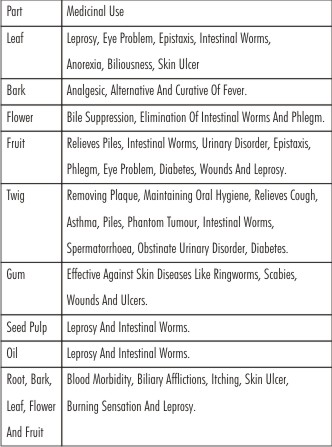 | Table – 1: Medicinal Uses Of Neem As Mentioned In Ayurveda
 |
Neem In Periodontics
Given its immunostimulant, antiulcerative, antifungal, antibacterial, antiviral, anticarcinogenic and antioxidant activity as well as its varying degrees of effect on central nervous system, Neem has been tried as an excellent microbial agent, pain reliever and tissue protector in Periodontics. Neem extracts are used to treat various skin diseases, as an antiseptic substance, against endo and ectoparasites or simply as a herbal mouthwash[14]. In test tubes, neem has been shown to have significant effects on both gram-positive and gram-negative organisms.
Extracts from neem sticks or bark have been shown to inhibit the growth of Streptococcus mutans. Some of the studies citing use of Neem in Periodontics have been enumerated in Table - 2.
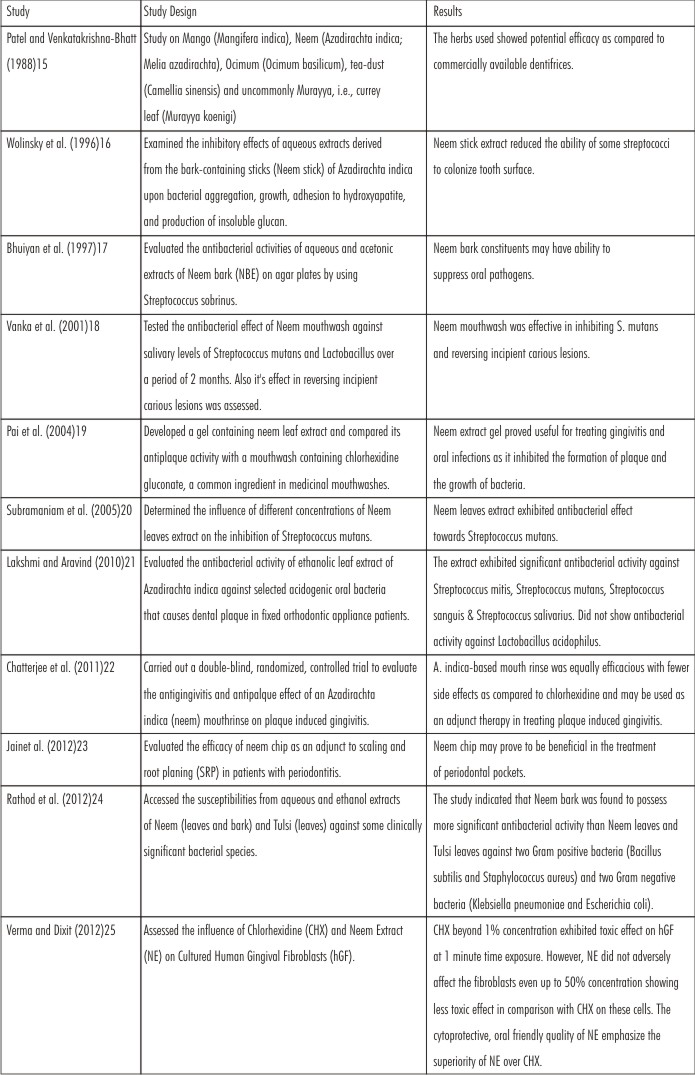 | Table – 2: Studies On Use Of Neem In Periodontics
 |
Turmeric (Curcuma Longa)
Turmeric or Curcuma longa, a perennial herb, is a member of the family Zingiberaceae (ginger). The plant grows to a height of three to five feet, and is cultivated extensively in India, China and other countries with a tropical climate.
The rhizome is the portion of the plant used medicinally; it is usually boiled, cleaned, and dried, yielding a yellow powder.
In old Hindu Medicine, it was extensively used for the treatment of sprains and swelling caused by injury. In recent times, traditional Indian medicine uses turmeric powder for the treatment of biliary disorders, anorexia, hepatic disorders, rheumatism and sinusitis.
Biological Activity of Turmeric and its derivative compounds
Turmeric powder, curcumin and its derivatives and many other extracts from the rhizomes were found to be bioactive. Some of the reported biological activities[26] are as follows:
1. Anti-inflammatory, antioxidant, anti-bacterial, anti-HIV, anti-tumor and arthritis.
2. Anti-bacterial, anti-HIV, antitumor, anti-inflammatory and anti-diabetic action.
3. Anti-bacterial, anti-HIV, arthritis, antioxidant, antitumor, anti-inflammatory, snake bite and apoptosis.
4. Antioxidant, anticarcinogenic effect, snakebite and arthritis.
5. Antioxidant, Alzheimer's disease, anti-bacterial and hepatoprotective effects.
6. Antispasmdic, anti-inflammatory, arthritis, gastrointestinal and cardiovascular effects.
7. Antioxidant, anticarcinogenic effect, antifibrotic effect and effect on immunity.
8. Anti-rheumatic activity, antioxidant and anticarcinogenic effect.
9. Arthritis, Alzherimer's and anti-inflammatory.
10. Abolished cytotoxic acitivity and antioxidant.
11. Ovarian and bone cancers.
12. Inhibitors of 5-lipoxygenase, cyclo-oxygenase and antileukemic.
13. CAKI-1 23 (renal cancer) and MCF-7 (breast cancer).
14. Inhibitors of HIV-1 integrase activity.
15. Antioxidant activity and hypocholestermic.
16. Turmeric also acts as a digestive agent.
Turmeric In Periodontics
Owing to its excellent anti-inflammatory, antimicrobial and wound healing properties use of turmeric and its derivatives has gained a momentum in the recent research in Periodontics. Some of the contemporary research with empirical evidence has been enumerated in Table - 3.
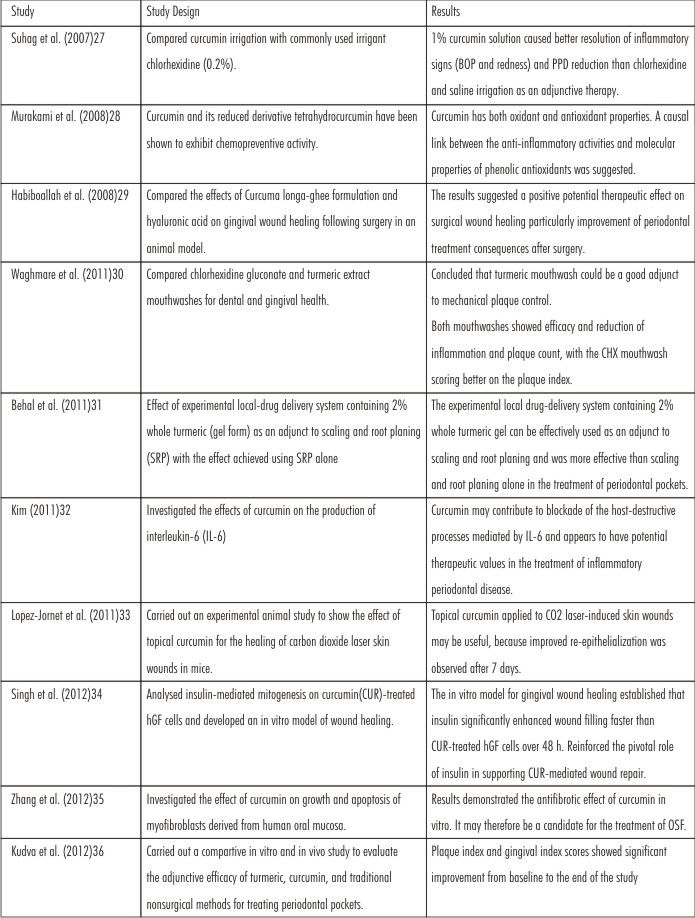 | Table – 3: Studies On Use Of Turmeric In Periodontics
 |
Clove (Syzygium Aromaticum)
Syzygium aromaticum(Linn.) Merr. & L.M. Perry (Syn. Eugenia aromatica) Kuntze, Eugenia caryophyllata Thunberg, belongs to family Myrtaceae, commonly known as clove, is an aromatic tree, native to Indonesia and used as a spice in cuisines in many parts of the world[37]. It is grown naturally in Moluku Islands of Indonesia and cultivated in many parts of the world like Tanzania, Madagascar, Sri Lanka, India, China, Indonesia, Malaysia, Brazil, Malagasy Republic, Jamaica and Guinea[38],[39]. It is an ever-green plant of 10 to 20 m in height with spear-shaped leaves and racemiferous yellowish flowers, has a strong phenolic smell and sharp acrid taste, whereas, essential oil of clove is a colorless or light yellowish fluid extracted from dried flower buds.
Clove In Periodontics
Although clove and clove oil have been used in dentistry as an analgesic from times immemorial and the use of eugenol, a derivative of clove has also a useful place in Endodontics, yet recent dental literature has shown empirical evidence of use of clove and its derivatives in periodontics.Some of the studies are enumerated in Table - 4.
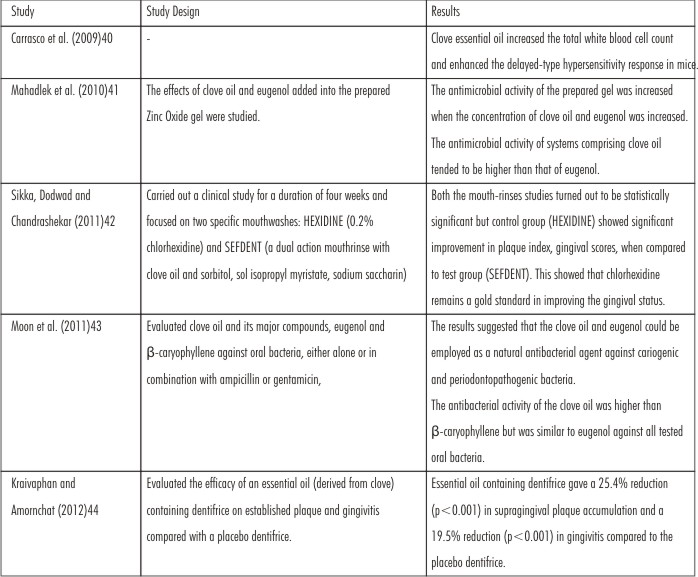 | Table – 4: Studies On Use Of Clove In Periodontics
 |
Tulsi (Ocimum Sanctum)
Ocimum sanctumL. (also known as Ocimum tenuiflorum, Tulsi or Basil) has been used for thousands of years in Ayurveda for its diverse healing properties. Tulsi, the Queen of herbs, the legendary 'Incomparable one' of India, is one of the holiest and most cherished of the many healing and healthy giving herbs of the orient. The sacred basil, Tulsi, is renowned[45] for its religious and spiritual sanctity, as well as for its important role in the traditional Ayurvedic and Unani system of holistic health and herbal medicine of the East.
Marked by its strong aroma and astringent taste, it is regarded in Ayurveda as a kind of 'elixir of life' and believed to promote longevity. Tulsi extracts are used in Ayurvedic remedies for common colds, headaches, stomach disorders, inflammation, heart disease, various forms of poisoning and malaria. Traditionally, O. sanctum is taken in many forms, as herbal tea, dried powder or fresh leaf[46].
Ocimum sanctumL. (Tulsi) is an erect, much branched sub-shrub 30-60 cm tall, with simple opposite green or purple leaves that are strongly scented and hairy stems. Leaves have petiole and are ovate, up to 5 cm long, usually somewhat toothed.
Tulsi In Periodontics
Given its excellent antimicrobial, anti-inflammatory, wound healing and immunoregulatory properties, Tulsi has always generated interest from dental community for use in treatment and protection against periodontal diseases. Some recent evidence regarding use of Tulsi in periodontics has been enumerated in Table - 5.
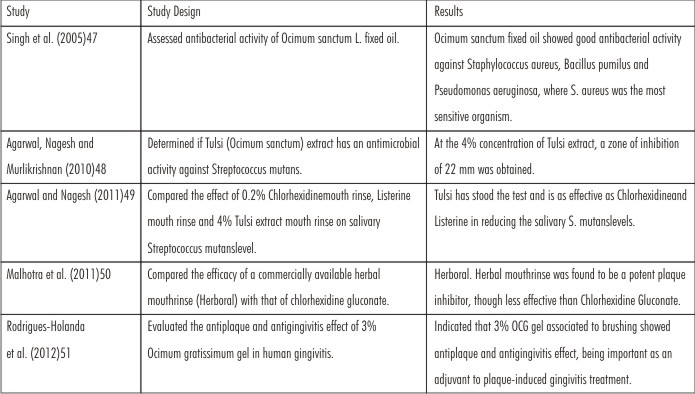 | Table – 5: Studies On Use Of Tulsi In Periodontics
 |
Conclusion
Overview of use of herbs in periodontal practice revealed that although a lot of work to experimentally evaluate the efficacy of these herbs in clinical periodontics has been done and some promising results have been shown, yet there is almost no practical use in clinical practice as yet. It is time now to substantiate the evidence obtained in preliminary studies and to carry out multicentric trials to prove the efficacy of these herbal remedies and to ensure that if they have any beneficial effect then they should get place in contemporary clinical use.
There is a need to build up a industry-laboratory relationship, despite having shown a better efficacy in experimental studies, if these experiments do not transform into medicinal products that can be used clinically then all this work would prove to be a shear waste of resources.
References
1. Malhotra R, Grover V, Kapoor A, Saxena D. Comparison of the effectiveness of a commercially available herbal mouthrinse with chlorhexidine gluconate at the clinical and patient level. Journal of Indian Society of Periodontology 2011; 15(4); 349- 352.
2. Bhandari MM. Flora of the Indian desert. 1st ed. Dhrti printers, NewDelhi,1990.
3. Ismail MYM, Aseem NM, Zakriya M. Botanicals Promoting Oral and Dental Hygiene: A Review. RJPBS 2010; 1(2): 202-206.
4. Johri. M. Neem: Rightly Called the 'Village Pharmacy', IST 2007 15:42:27.
5. Chitme HR, Chandra R, and Kaushik S, “Studies on antidiarrheal activity of calotropis gigantea R. Br. in experimental animals,” Journal of Pharmacy & Pharmaceutical Sciences, 2003; 7: 70-75.
6. Cowan MM. “Plant products as antimicrobial agents,” Clinical Microbiology Reviews 1999; 12(4): 564–582.
7. Kalemba D and Kunicka A. “Antibacterial and antifungal properties of essential oils. CurrentMedicinal Chemistry2003; 10(10): 813-829.
8. Chopra, R. N., Nayer, S. L. and Chopra, I. C., Glossary of Indian Medicinal Plants, CSIR, New Delhi, 1956.
9. Kirtikar, K. R. and Basu, B. D., in Medicinal Plants (eds Blatter, E., Cains, J. F., Mhaskar, K. S.), Vivek Vihar, New Delhi, 1975, p. 536
10. Chatterjee, A. and Pakrashi, S. (eds), The Treatise on Indian Medicinal Plants, 1994, vol. 3, p. 76.
11. Ketkar, A. Y. and Ketkar, C. M., in The Neem Tree: Source of Unique Natural Products for Integrated Pest Management, Medicine, Industry and Other Purposes (ed. Schmutterer, H.), 1995, pp. 518–525.
12. Mitra CR. Neem, Dr M. S. Patel, Indian Central Oilseeds Committee, Hyderabad, 1963, pp. 69–94.
13. Varma, G. S., Miracles of Neem Tree, Rasayan Pharmacy, New Delhi, 1976.
14. Kukreja BJ, Dodwad V. Herbal mouthwashes – a gift of nature. Int. J. Pharm. Bio Sciences 2012; 3(2): 46-52.
15. Patel VK, Venkatakrishna-Bhatt H. Folklore therapeutic indigenous plants in periodontal disorders in India (review, experimental and clinical approach).. Int J Clin Pharmacol Ther Toxicol. 1988 Apr;26(4):176-84.
16. Wolinsky LE, Mania S, Nachnani S, Ling S. The Inhibiting Effect of Aqueous Azadirachta indica (Neem) Extract Upon Bacterial Properties Influencing in vitro Plaque Formation. J. Dent. Res. 1996; 75(2): 816-822.
17. Bhuiyan MM, Nishimura M, Matsumara S, Shimono T. Antibacterial effects of the crude Azadirachta indica bark extract on Streptococcus sobrinus. Pediatric Dental J. 1997; 7(1): 61-64.
18. Vanka A, Tandon S, Rao SR, Udupa N, Ramkumar P. The effect of indigenous Neem Azadirachta indica [correction of (Adirachta indica)] mouth wash on Streptococcus mutans and lactobacilli growth. Indian J Dent Res. 2001 Jul-Sep;12(3):133-44.
19. Pai MR, Acharya LD, Udupa N. Evaluation of antiplaque activity of Azadirachta indica leaf extract gel—a 6-week clinical study. J Ethnopharmacol. February 2004;90(2-3):99-103.
20. Subramaniam SK, Siswomihardjo W, Sunarintyas S. The effect of different concentrations of Neem (Azadiractha indica) leaves extract on the inhibition of Streptococcus mutans (In vitro). Maj. Ked. Gigi. (Dent. J.) 2005;38(4): 176–179.
21. Lakshmi T, Aravinda Kumar S. Antibacterial evaluation of azadirachta indica ethanolic leaf extract against selected acidogenic oral bacteria causing dental plaque in fixed orthodontic appliance patients – an invitro study. Journal of Bio-Technology and Research 2010; 2(2): 1-7.
22. Chatterjee A, Saluja M, Singh N, Kandwal A. To evaluate the antigingivitis and antipalque effect of an Azadirachta indica (neem) mouthrinse on plaque induced gingivitis: A double-blind, randomized, controlled trial. J Indian Soc Periodontol 2011;15:398-401
23. Jain S, Kaur H, Brar S. To Evaluate The Efficacy Of Neem Chip As An Adjunct To Scaling And Root Planing (SRP) in patients with Periodontitis. Ind. J. Dent. Sc. 2012; 4(4) Suppl.: 042-045.
24. Rathod GP, Kotecha BM, Sharma R, Amin H, Prajapati PK. In vitro Antibacterial study of two commonly used medicinal plants in Ayurveda: Neem (Azadirachta indica L.) and Tulsi (Ocimum sanctum L.). International Journal of Pharmaceutical & Biological Archives 2012; 3(3):582-586.
25. Verma UP, Dixit J. Development of a human gingival fibroblast (HGF) cell line for the evaluation of a novel mouthwash from Azadirachta indica vis-à-vis chlorhexidine. Int. J. Pharmacy and Pharmaceutical Sciences 2012; 4(2): 217-221.
26. Gupta SK, Lather A, Jaiswal V, Garg S, Jyoti, Kumar A. Phytochemistry of Curcuma longa – An overview. JPBMS 2010; 4(1): 1-8.
27. Suhag A, Dixit J, Dhan P. Role of curcumin in periodontal disease. Perio 2007; 4(2): 115-121.
28. Murakami Y, Ishii H, Takada N, Tanaka S, Machino M, Ito S, Fujisawa S. Comparative Anti-inflammatory Activities of Curcumin and Tetrahydrocurcumin Based on the Phenolic O-H Bond Dissociation Enthalpy, Ionization Potential and Quantum Chemical Descriptor. Anticancer Res. 2008; 28: 699-708.
29. Habiboallah G, Nasroallah S, Mahdi Z, Nasser MS, Massoud Z, Ehsan BN, Mina ZJ, Heidar P. Histological evaluation of Curcuma longa-ghee formulation and hyaluronic acid on gingival healing in dog. J Ethnopharmacol.2008 Dec 8;120(3):335
30. Waghmare PF, Chaudhari AU, Karhadkar VM, Jamkhande AS. Comparative evaluation of turmeric and chlorhexidine gluconate mouthwash in prevention of plaque formation and gingivitis: A clinical and microbiological study. J Contemp Dent Pract. 2011;12(4):221-224.
31. Behal R, Mali AM, Glida SS, Paradkar AR. Evaluation of local drug-delivery system containing 2% whole turmeric gel used as an adjunct to scaling and root planing in chronic periodontitis: A clinical and microbiological study. J Indian Soc Periodontol. 2011 Jan-Mar; 15(1): 35–38.
32. Kim S-J. Curcumin suppresses the production of interleukin-6 in Prevotella intermedia lipopolysaccharide-activated RAW 264.7 cells. J Periodontal Implant Sci 2011;41:157-163
33. López-Jornet P, Camacho-Alonso F, Jiménez-Torres MJ, Orduña-Domingo A, and Gómez-García F. Photomedicine and Laser Surgery. 2011; 29(12): 809-814.
34. Singh N, Ranjan R, Zaidi D, Shyam H, Singh A, Lodha D, Sharma R, Verma U, Dixit J, Balapure AK. Insulin catalyzes the curcumin-induced wound healing: An in vitro model for gingival repair. Ind. J. Pharmacol. 2012; 44(4): 456-462.
35. Zhang S-S, Gong Z-J, Li W-H, Wang X, Ling T-Y. Antifibrotic Effect of Curcumin in TGF-β1-Induced Myofibroblasts from Human Oral Mucosa. Asian Pacific J Cancer Prev, 2012; 13, 289-294
36. Kudva P, Tabasum ST, Gupta S. Comparative evaluation of the efficacy of turmeric and curcumin as a local drug delivery system: a clinicomicrobiological study. Gen Dent. 2012 Sep-Oct;60(5):e283-7.
37. Srivastava KC and Malhotra N. Acetyl euginol, a component of oil of cloves (Syzygium aromaticum L.) inhibits aggregation and alters arachidonic acid metabolism in human blood platelets. Prostaglandins Leukot Essent Fatty Acids. 1991;42(1):73-81.
38. Zheng GQ, Kenney PM and Lam LK. Sesquiterpenes from clove (Eugenia caryophyllata) as potential anticarcinogenic agents. J Nat Prod. 1992;55(7):999-1003
39. Baytop T. Therapy with Medicinal Plants in Turkey. 2nd ed. Nobel Medical Bookstore: İstanbul-Turkey; 1999
40. Carrasco FR, Schmidt G, Romero AL, Sartoretto JL, Caparroz-Assef SM, Bersani-Amado CA, Cuman RK. Immunomodulatory activity of Zingiber officinale Roscoe, Salvia officinalis L. and Syzygium aromaticum L. essential oils: evidence for humor- and cell-mediated responses. J Pharm Pharmacol. 2009 Jul;61(7):961-7.
41. Mahadlek J, Charoenteeraboon J, Phaechamud T. Zinc Oxide Gels for Periodontitis Treatment. Journal of Metals, Materials and Minerals 2010; 20(3): 159-163.
42. Sikka G, Dodwad V, Chandrashekar KT. Comparative Anti-plaque and Anti-gingivitis Efficacy of Two Commercially Available Mouthwashes - 4 Weeks Clinical Study. J Oral Health Comm Dent 2011;5(3)110-112
43. Moon SE, Kim HY, Cha JD. Synergistic effect between clove oil and its major compounds and antibiotics against oral bacteria. Arch Oral Biol. 2011 Sep;56(9):907-16.
44. Kraivaphan P, Amornchat C. Effect of an essential oil-containing dentifrice on established plaque and gingivitis. Southeast Asian J TropMed Public Health 2012; 43(1): 243-248.
45. Warrier PK. In: Longman O, editor. Indian Medicinal Plants. New Delhi, CBS publication, 1995. p. 168.
46. Biswas NP, Biswas AK. Evaluation of some leaf dusts as grain protectant against rice weevil Sitophilus oryzae (Linn.). Environ Ecol 2005;23:485-8.
47. Singh S, Malhotra M, Majumdar DK. Antibacterial activity of Ocimum sanctum L. fixed oil. Indian J Exp Biol.2005 Sep;43(9):835-7.
48. Agarwal P, Nagesh L, Murlikrishnan. Evaluation of the antimicrobial activity of various concentrations of Tulsi (ocimum sanctum) extract against streptococcus mutans: An in vitro study . Indian Journal of Dental Research 2010; 21; 3357-359
49. Agarwal P, Nagesh L. Comparative evaluation of efficacy of 0.2% Chlorhexidine, Listerine and Tulsi extract mouth rinses on salivary Streptococcus mutans count of high school children--RCT. Contemporary Clinical Trials 2011; 32(6): 802-808.
50. Malhotra R, Grover V, Kapoor A, Saxena D. Comparison of the effectiveness of a commercially available herbal mouthrinse with chlorhexidine gluconate at the clinical and patient level. J Indian Soc Periodontol. 2011 Oct-Dec; 15(4): 349–352.
51. Rodrigues Holanda J, de Santiago Dutra C, Moreira de Olinda T, do Nascimento Gomes K, Lima V, Goes P. Antiplaque and antigingivitis effect of ocimum gratissimum gel: a randomized double-blinded clinical trial. Braz. J. Periodontol. 2012; 22(3): 70-74.
|